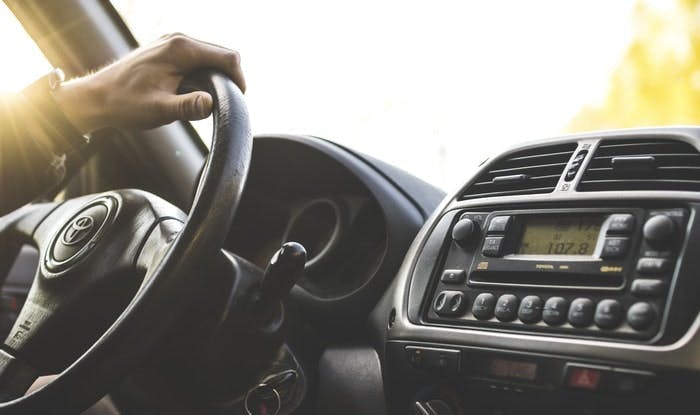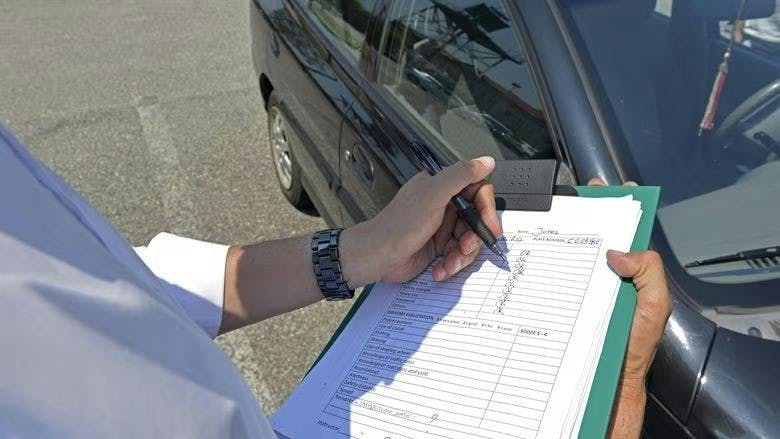
There’s nothing that gets learner drivers as frazzled and nervous as finishing their lessons and going in for their driving test. With the pressure on, many find it difficult to keep enough of a level head to pass.
Fortunately, you’ve come to the right place. As experts on every aspect of driving, we've no shortage of practical test tips to help you impress your driving examiner. Read on to boost your chances of driving away with a shiny new licence!
Before we get into the good stuff, we do need to state that while there are ways you can influence the outcome of your test positively, there isn’t a foolproof way to impress the examiner and get them to overlook any mistakes you’ve made along the way.
Our tips will require you to put in the effort, but they will pay off in the long run.
1. Make a good first impression

While first impressions won't play into the examiner's final feedback at all, it's a nice touch if you make an effort. Do you really want them to think that you don’t care about your test because you’re slouching and forgot to take out your provisional licence?
Thankfully, there are a few things you can do to help them get a good impression.
When you get to the test centre waiting room, make sure you’ve got your photo-card provisional licence at the ready—the examiner will ask you to hand it over briefly once they’ve called you over. Don’t leave it in your pocket or wallet—it doesn’t look good if you make them wait while you search for it. Once they’ve looked at your licence, they’ll get you to fill in a few details on a form before heading out with you to start your practical.
It might be worthwhile trying to figure out what type of examiner you’ve got. Are they chatty or are they a bit more reserved? Generally speaking, most examiners will initiate some kind of conversation to put you at ease during your test. It’s not intended to be a method of distraction—just a way to help you relax a little and get rid of those test day nerves.
It could be beneficial to push for small talk with the examiner—as long as it doesn’t distract you from the task at hand. Examiners have to moderate several tests in a day, so it can get pretty boring for them. Chatting with them might alleviate any tension you have and lighten their mood. If you’re easily distracted, however, you might find it better to keep quiet.
If you’d like, you could commentate on what you’re doing. It might sound silly, but it’s a method that many learners use, e.g., “Checking my left mirror, indicating and switching to first gear”. It gives you something to concentrate on and helps the examiner understand what you’re doing. Do whatever is suitable for your own driving style. As long as you’re confident that what you’re doing won’t impact your driving negatively, go right ahead!
The bottom line is that you should at the very least treat your examiner with respect. You might be surprised to learn that cases of examiner assault are on the rise.
To summarise:
- Have your licence at the ready
- Give the examiner a smile—be friendly
- Decide if you want to join in with small talk
- Commentate on your driving if it helps
2. Perseverance is key

Want to know what really catches out learner drivers? Thinking they’ve failed for something mid-test and giving up as a result. Whether it’s stalling the car or taking a wrong turn, once a learner thinks they’ve made a mistake, that’s it—they go into total meltdown mode.
The important thing to take away from this is to not dwell on your mistakes—it will only throw you off balance and play on your mind for the rest of your test. It’s not like you can erase your mistakes by thinking about them—or erase the marks on the examiner’s feedback sheet.
You can, however, give yourself the best chance possible of passing by continuing. How does the saying go? Keep calm and carry on! This couldn’t be any truer for learner drivers. There’s no guarantee that something you think is an automatic fail will actually result in a fail. So keep that in mind.
Stalled the car? Take a deep breath and restart. Forgotten to check your blind spot? Keep it in mind so that you don’t make the same mistake—build up too many and your minors will turn into majors. You are allowed to make mistakes on your test, but it’s up to you as to whether they end up resulting in a fail or not.
To summarise:
- You're allowed to make mistakes
- Don't dwell on them
- Keep calm and carry on
- Avoid making the same mistake twice
3. Be confident, but cautious
Throughout the driving test, candidates are expected to walk a fine line between safe and confident. For many learners, it can be extremely difficult to do both. Sometimes you think you’ve got enough time to emerge from a junction, showing confidence—but it turns out you’re being over-confident and disregarding safety.
A polar opposite situation you might find yourself in is when you’re not sure if you’ve got enough time to emerge—sitting at a junction for minutes, when you could have gone several times over. The examiner wants you to display confidence but also exercise caution when necessary.
So, don’t rush—you won’t benefit from speeding or narrowly missing a car because you’re so desperate to get going. On the other hand, showing undue hesitation will only tell them that you’re not ready to be on the roads unsupervised.
Don’t let other road users influence you on your test—they’re not the ones being tested, you are. Your examiner isn’t going to let you off just because you’re mimicking the speed of other drivers, for example. You’ll find it useful to just remember one thing throughout your test: stick to what you know.
Throughout your lessons, your instructor will have taken you through everything you could possibly need to get test-ready. You might not realise it, but your instructor has helped you carefully cultivate a safe driving style. So why would you change it during the test?
Driving anxiety and nerves aside, you shouldn’t actively change your driving style just because you think the examiner might like it. Remember what you’ve been taught by your instructor—if you need a reminder, maybe you should bring your instructor on your test so their presence will ground you.
To summarise:
- Be confident but err on the side of caution
- Don't let other road users influence you
- Stick to what you know
- Bring your instructor with you
4. Be open with the examiner

Throughout your practical, your examiner will be looking for constant proof that you’re a safe driver—someone they’d be comfortable passing to drive unsupervised in the future.
While some learners do manage to come out on top with a clean sheet—making it into our zero minors club—most end up making a few mistakes along the way. It’s how you handle these mistakes that will determine whether it’s a minor or major fault.
Showing perseverance is of course important, but it’s not the only thing. When you make a clear mistake on your test, like showing too much hesitation, it might help you to briefly inform the examiner that you’re aware you’ve made a mistake.
But won’t that just draw attention to my mistakes, you ask? Yes and no.
By pretending you’ve not made a mistake, the examiner might mistakenly assume that you’re oblivious. By drawing attention to it, you’re taking responsibility. It also pushes you not to make the same mistake twice. Obviously, it will mean that the examiner will be more likely to test you or closely monitor you on that particular area. But even if you don’t bring it up, they will have noticed—it’s what they’re trained for.
Sometimes, of course, we make obvious mistakes. Stalling, for example, is something the examiner won’t miss—no matter how much you pretend it didn’t happen. Talking it over with the examiner can help ease your nerves.
After stalling in my test, I found talking it over with the examiner to be a great stress reliever. It helped calm my nerves while I went about restarting the car and setting off.
To summarise:
- Keep a level head
- Own your mistakes
- Try not to make the same mistake twice
- Talk it over
5. Know what they're looking for

As we’ve said, examiners are looking for you to display natural, safe and confident driving. They’re not looking for any special tricks. It’s exactly the same as what you’d do on a lesson with your instructor—you’re just being graded on it instead.
Your instructor will have taken you around your test centre prior to your test—so you should be relatively familiar with the surrounding area. While you won’t know the exact test route, it shouldn’t make too much of a difference. Pay close attention to speed limits and changes—many a learner has failed because they’ve not realised there’s been a change in speed limit.
Preparation is key. If you think you’re approaching a hazard, plan ahead! You’ll need to give yourself plenty of time to adjust on road types like roundabouts and busy junctions. When you’re asked to demonstrate a manoeuvre—pulling up on the right, bay parking or parallel parking—keep it nice and slow and don’t forget your observations!
A lot of people advise learners to exaggerate their mirror checks so that the examiner knows you’re doing them. This isn’t really necessary. The examiner will be watching you closely, so they'll be able to tell if you're making correct observations.
To get a better look at what examiners are looking for during the practical, take a look at the different types of driving test faults you’ll be marked on.
Common types of faults
- Observation
- Hesitation
- Awareness and planning
- Following distance
- Not giving correct signals
- Poor lane discipline
You’ll pass your driving test so long as you make no major faults and no more than 15 minor faults—not too shabby!
To summarise:
- Just act as you would on a lesson
- Prepare for anything
- Observations are key!
- Read up on driving test faults
Conclusion
Essentially, you just need to do what’s expected of you during your driving test. The examiner isn’t looking for you to do anything more than replicate what you’ve learnt in your driving lessons on an unfamiliar test route. It’s challenging, but not impossible—they’re not trying to trick you. If anything, they want you to pass more than you do—it’ll mean they won’t have to see you again (nothing personal—they've just got a lot of people to get through!).
Despite what the top driving test myths might have you believe, examiners don't have a pass/fail quota! If you really want to impress your examiner, the best way to do so is to find an instructor who will teach you the driving skills you need to show that you’re a safe and confident driver.
Looking for lessons? You’ve come to the right place. Whether you’re a complete beginner or someone who’s almost test-ready, PassMeFast has a course for everyone. With one of our experienced, DVSA-approved instructors, you can learn all the essential driving skills you need to pass your test with flying colours.
Give us a call on 0333 123 4949 or book online to get started right away.
Subscribe for driving advice, offers & more
We'd love to let you know about our courses, news and offers via email. You may unsubscribe at any time.
Star Genie Limited trading as PassMeFast. Company number 10093359
Copyright © 2024 owned by Star Genie Limited
PassMeFast, Blue Tower, MediaCityUK, Salford, M50 2ST

